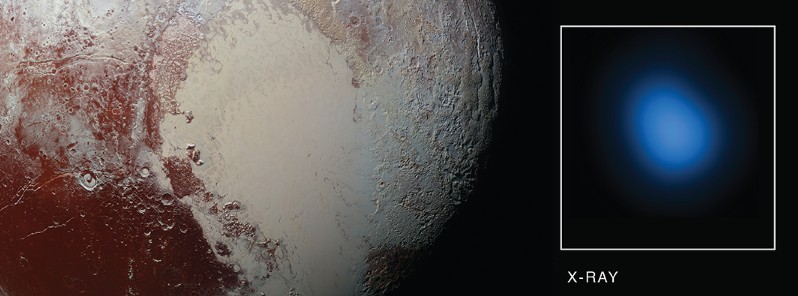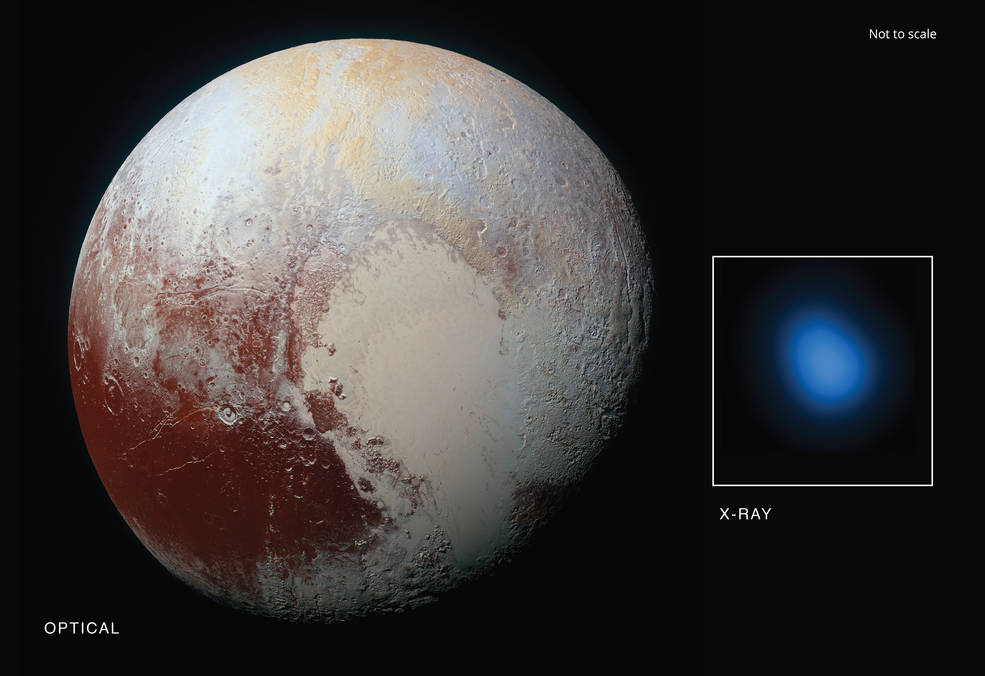New insight into the space environment surrounding Pluto

Chandra X-ray Observatory was aimed several times at Pluto from February 2014 through August 2015 and made a surprising detection of X-rays being emitted from this largest and best-known object in the Solar System's outermost regions. The observations offer new insight into the space environment surrounding Pluto.
Chandra was observing Pluto and gathering data that the New Horizons mission managers could compare after their spacecraft makes a close encounter with the dwarf planet. Each time Chandra pointed at Pluto, four times in all, it detected low-energy X-rays being emitted.
"We've learned that Pluto is interacting with the solar wind in an unexpected and energetic fashion," said Carey Lisse, an astrophysicist at the Johns Hopkins University Applied Physics Laboratory (APL) in Laurel, Maryland, who led the Chandra observation team with APL colleague and New Horizons Co-Investigator Ralph McNutt. "We can expect other large Kuiper Belt objects to be doing the same."
The report details what Lisse says was a somewhat surprising detection given that Pluto – being cold, rocky and without a magnetic field – has no natural mechanism for emitting X-rays. But Lisse, having also led the team that made the first X-ray detections from a comet two decades ago, knew the interaction between the gases surrounding such planetary bodies and the solar wind, the constant streams of charged particles from the Sun that speed throughout the solar system, can create X-rays.
New Horizons scientists were particularly interested in learning more about the interaction between the gases in Pluto's atmosphere and the solar wind. The spacecraft itself carries an instrument designed to measure that activity up-close and scientists are using that data to craft a picture of Pluto that contains a very mild, close-in bow shock, where the solar wind first "meets" Pluto (similar to a shock wave that forms ahead of a supersonic aircraft) and a small wake or tail behind the planet.
The immediate mystery is that Chandra's readings on the brightness of the X-rays are much higher than expected from the solar wind interacting with Pluto's atmosphere.
"Before our observations, scientists thought it was highly unlikely that we'd detect X-rays from Pluto, causing a strong debate as to whether Chandra should observe it at all," said co-author Scott Wolk, of the Harvard-Smithsonian Center for Astrophysics in Cambridge, Mass. "Prior to Pluto, the most distant solar system body with detected X-ray emission was Saturn’s rings and disk."

The first detection of Pluto in X-rays has been made using NASA’s Chandra X-ray Observatory in conjunction with observations from NASA’s New Horizon spacecraft. Credits: X-ray: NASA/CXC/JHUAPL/R.McNutt et al; Optical: NASA/JHUAPL
The Chandra detection is especially surprising since New Horizons discovered Pluto's atmosphere was much more stable than the rapidly escaping, "comet-like" atmosphere that many scientists expected before the spacecraft flew past in July 2015. In fact, New Horizons found that Pluto's interaction with the solar wind is much more like the interaction of the solar wind with Mars, than with a comet. However, although Pluto is releasing enough gas from its atmosphere to make the observed X-rays, in simple models for the intensity of the solar wind at the distance of Pluto, there isn't enough solar wind flowing directly at Pluto to make them.
Lisse and his colleagues suggest several possibilities for the enhanced X-ray emission from Pluto. These include a much wider and longer tail of gases trailing Pluto than New Horizons detected using its SWAP (Solar Winds At Pluto) instrument. Other possibilities are that interplanetary magnetic fields are focusing more particles than expected from the solar wind into the region around Pluto, or the low density of the solar wind in the outer solar system at the distance of Pluto could allow for the formation of a doughnut, or torus, of neutral gas centered around Pluto's orbit.
"When you have a chance at a once in a lifetime flyby like New Horizons at Pluto, you want to point every piece of glass, every telescope on and around Earth, at the target," McNutt says. "The measurements come together and give you a much more complete picture you couldn't get at any other time, from anywhere else."
Source: NASA/Chandra
Reference:
- "The puzzling detection of x-rays from Pluto by Chandra" – C.M. Lisse et al. – Icarus – 2016 – http://dx.doi.org/10.1016/j.icarus.2016.07.008
Featured image credit: X-ray: NASA/CXC/JHUAPL/R.McNutt et al; Optical: NASA/JHUAPL

Commenting rules and guidelines
We value the thoughts and opinions of our readers and welcome healthy discussions on our website. In order to maintain a respectful and positive community, we ask that all commenters follow these rules.